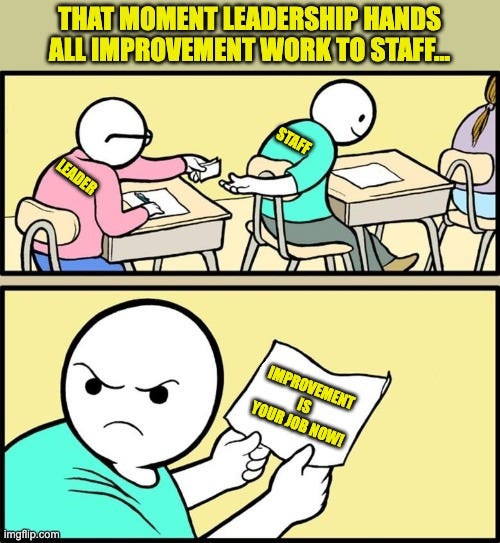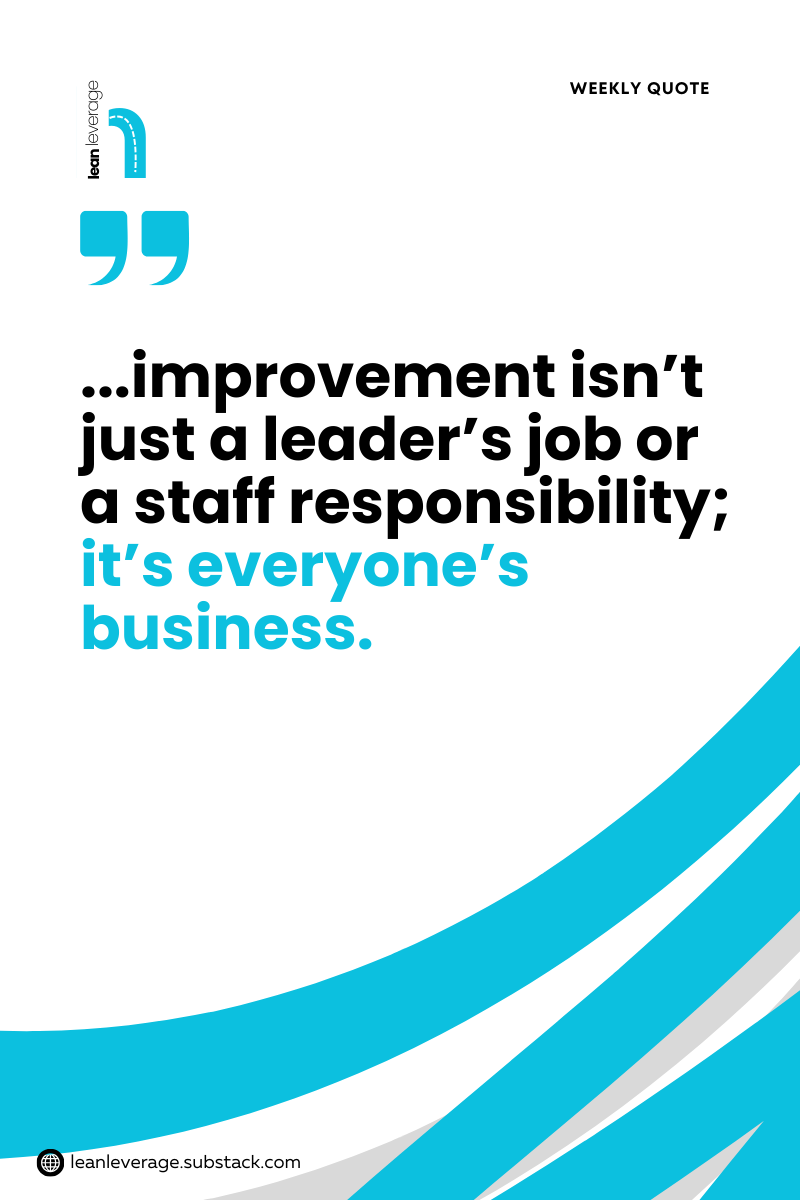Who Owns Improvement? (And Why Most Teams Get This Wrong)
A deep dive into the role of leadership vs. staff in sustaining CI, and why many organisations fail because they push ownership to the wrong place.
Hello friends,
One of the fastest ways to frustrate a Continuous Improvement (CI) programme is to put ownership in the wrong hands. I’ve seen this play out across industries I’ve worked in, Marketing, Engineering, Fintech, Tech, and now Healthcare.
Everyone agrees on the “why” of improvement: fewer errors, faster processes, less waste, and maximising value for customers. But when it comes to the “who” - who actually owns improvement, things get messy.
The common mistake?
Leaders assume staff “on the ground” should own all of it, since they’re closest to the work. Meanwhile, staff look back at leadership thinking, “This is your initiative. You people should run it.”
And so, the baton keeps getting passed around like hot akara. Nobody wants to hold it for too long. Some improvement huddles don’t run if the manager is away. Some project meetings collapse if one person is off sick. And before you know it, momentum dies.
Why Teams Get It Wrong
1. Leaders push responsibility down.
“Staff should own improvement because they know the process best.” True… but incomplete.
I see where this logic comes from. Frontline staff are closest to the work, so yes, they spot problems first. And when leaders send their teams for Lean training, that’s fantastic. It equips them with tools for opportunity identification and problem-solving.
But is that enough? NO.
If leadership stops there, it’s a half-measure.
Improvement needs more than trained staff. It needs leaders who actively support, resource, and clear obstacles. Without that, “staff ownership” quickly becomes lip service. “Cho-cho-cho no workings”
2. Staff push responsibility up.
On the flip side, staff sometimes say:
“Improvement is management’s job. After all, they make the big decisions.” True… but also incomplete.
Leaders don’t live the process daily. They don’t experience the small frustrations, the repeat work, the wasted steps. If staff don’t engage, practical ideas never surface.
And if every change has to come top-down, then leaders will never leave the office in time for dinner with their families. Improvement will become another burden squeezed into already crowded agendas.
3. No clear system.
This is where things often break. Improvement gets treated as an “extra task” instead of being built into how we work.
So the moment deadlines, crises, or office politics show up, improvement is placed on the back burner. The cycle repeats: it starts strong, fizzles out, and gets buried under “more urgent” work.
The Big Question: Who Owns Improvement?
The truth: ownership is shared, but definitely not equally.
Leaders own the system.
They set direction, create urgency, allocate resources, remove barriers, and provide the right environment. Beyond signing off papers in the boardroom, leaders must show up where the work happens. Without their visible commitment, improvement quickly slips into a “low-priority” activity.Staff own the execution.
They bring the insights leaders can’t see, test the changes, and call out waste no manager would notice from a dashboard. Without their hands-on involvement, improvement stays theoretical.
It’s a partnership. Think of it like a car: leaders provide the vehicle, the fuel, and the roadmap. Staff are the ones steering, braking, and navigating junctions. If either side checks out, the car goes nowhere.
Why This Matters
When organisations misplace ownership, one of two terrible outcomes usually shows up:
The “initiative of the season” syndrome:
Leaders launch something shiny, then abandon it when results lag. Staff quickly learn to roll their eyes, do absolutely nothing and wait it out, knowing the next shiny initiative is just around the corner.The burnout trap.
Staff carry the burden of improvement with no leadership support. Without resources or authority, they get frustrated, and the energy fizzles out.
But when ownership is aligned, improvement becomes natural. Teams question, adapt, and refine continuously. Not because someone forced them, but because it’s baked into the culture.
As I’ve written before, staff must see improvement as something done for them, not done to them.
The Way Forward?
So, how do we stop playing hot akara with ownership?
Three shifts:
Leaders: show up.
Improvement isn’t something to delegate away. Walk the Gemba. Ask better questions. Celebrate results, even the small wins.Staff: step up.
Improvement isn’t optional. Speak up about waste. Test small changes. Own your piece of the process.Everyone: make it daily work.
Improvement isn’t a side project. It’s how the team breathes. Small, consistent actions will always beat grand, occasional efforts.
Wrapping It Up
At the end of the day, improvement isn’t just a leader’s job or a staff responsibility; it’s everyone’s business. Leaders must create the right environment and show commitment, while teams must step up with ideas and energy. When both sides pull together, that’s when organisations truly build a culture of continuous improvement that lasts.
On a personal note, I really appreciate all the kind words and messages many of you send me. It genuinely keeps me going. But would also love to see more of those thoughts in the comments section, whether here on Substack or on LinkedIn. It not only shows me you’ve read and enjoyed the post, but it also pushes me to keep writing and sharing more.
Tomiwa Femi-Philips
Continuous Improvement Enthusiast





A top down, bottom up, collaborative approach always works best.
All employees should be empowered to ‘lead from wherever they stand’.
This is so insightful. Lots of value!